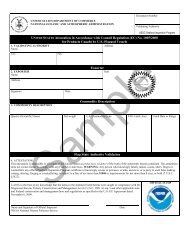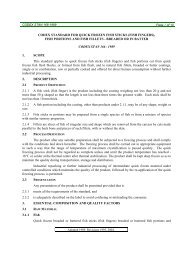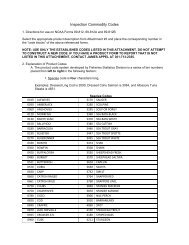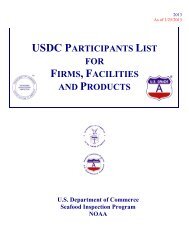Customs Labeling - Seafood Inspection Program
Customs Labeling - Seafood Inspection Program
Customs Labeling - Seafood Inspection Program
You also want an ePaper? Increase the reach of your titles
YUMPU automatically turns print PDFs into web optimized ePapers that Google loves.
Chapter 1-United States <strong>Customs</strong> Service<br />
articles. Goods of a NAFTA country shall be marked by any reasonable method which is legible, conspicuous<br />
and permanent as otherwise provided in this part.<br />
(b) Watch, clock, and timing apparatus. The country of origin marking requirements on watches, clocks, and<br />
timing apparatus are intensive and require special methods. (See §11.9 of this chapter and Chapter 91,<br />
Additional U.S. Note 4, Harmonized Tariff Schedule of the United States (19 U.S.C. 1202)).<br />
(c) Native American-style jewelry-(1) Definition. For the purpose of this provision, Native American-style<br />
jewelry is jewelry which incorporates traditional Native American design motifs, materials and/or construction<br />
and therefore looks like, and could possibly be mistaken for, jewelry made by Native Americans.<br />
(2) Method of marking. Except as provided in 19 U.S.C. 1304(a)(3) and in paragraph (c)(3) of this section,<br />
Native American-style jewelry must be indelibly marked with the country of origin by cutting, die-sinking,<br />
engraving, stamping, or some other permanent method. The indelible marking must appear legibly on the clasp<br />
or in some other conspicuous location, or alternatively, on a metal or plastic tag indelibly marked with the<br />
country of origin and permanently attached to the article.<br />
(3) Exception. If it is technically or commercially infeasible to mark in the manner specified in paragraph<br />
(c)(2) of this section, or in the case of a good of a NAFTA country, the article may be marked by means of a<br />
string tag or adhesive label securely affixed, or some other similar method.<br />
(d) Native American-style arts and crafts-(1) Definition. For the purpose of this provision, Native American-style<br />
arts and crafts are arts and crafts, such as pottery, rugs, kachina dolls, baskets and beadwork, which<br />
incorporate traditional Native American design motifs, materials and/or construction and therefore look like,<br />
and could possibly be mistaken for, arts and crafts made by Native Americans.<br />
(2) Method of Marking. Except as provided for in 19 U.S.C. 1304(a)(3) and §134.32 of this part, Native<br />
American-style arts and crafts must be indelibly marked with the country of origin by means of cutting,<br />
die-sinking, engraving, stamping, or some other equally permanent method. On textile articles, such as rugs, a<br />
sewn in label is considered to be an equally permanent method.<br />
(3) Exception. Where it is technically or commercially infeasible to mark in the manner specified in paragraph<br />
(d)(2) of this section, or in the case of a good of a NAFTA country, the article may be marked by means of a<br />
string tag or adhesive label securely affixed, or some other similar method.<br />
(e) Assembled articles. Where an article is produced as a result of an assembly operation and the country of<br />
origin of such article is determined under this chapter to be the country in which the article was finally<br />
assembled, such article may be marked, as appropriate, in a manner such as the following:<br />
(1) Assembled in (country of final assembly);<br />
(2) Assembled in (country of final assembly) from components of (name of country or countries of origin of all<br />
components); or<br />
(3) Made in, or product of, (country of final assembly).<br />
[T.D. 72-262, 37 FR 20318, Sept. 29, 1972, as amended by T.D. 89-1, 53 FR 51255, Dec. 21, 1988; T.D.<br />
89-88, 54 FR 39524, Sept. 27, 1989; T.D. 90-75, 55 FR 38317, Sept. 18, 1990; T.D. 90-78, 55 FR 40166,<br />
17<br />
Attachment #1<br />
(May 1985)






